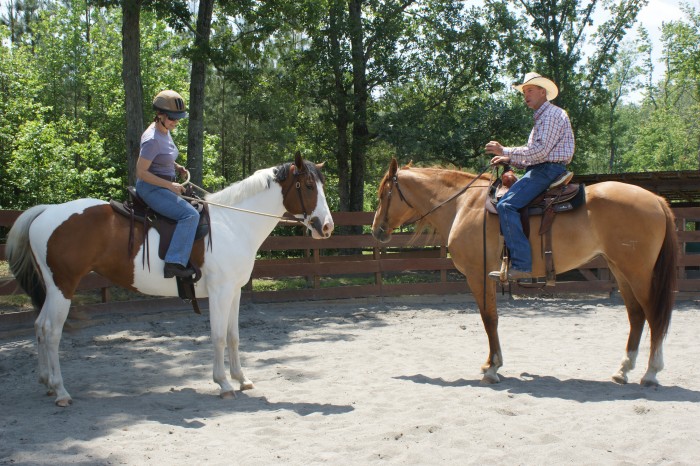
Unless you have a lazy horse, you probably had to put a good deal of effort into developing a good stop on your equine. If he stops, that is…!
What I often see in clinics and lessons are riders that allow their horses to take their time stopping…it might take them a quarter of the arena before they get their horses stopped. Dribbling is for basketball—not riding!
With that being said lets take a look at what happens with the horse when we ask for the stop. From the horse’s perspective, we too often pick up aggressively when we ask for the stop without cadence or rhythm, causing the horse to push or root into the sudden pressure. Have we ever given them a better way through understanding? I bet not.
If you’re in the, “I need to improve my stop” camp, here’s a good exercise that will help you out.
So, first let’s establish rhythm with the horse. Walk a straight line with your horse. Feel his footfalls as he walks. Now, count his left foot when it leaves the ground traveling forward…left, left, left, left, etc. Each time that foot leaves the ground, call out it out. Have a friend watch from the ground to help you in your feel.
Now, let’s add the right foot as well. Left, right, left, right, left, right, left, right, and so on.
After you feel like you have the hang of the steps and calling the rhythm, let’s work on that stop. Count each step backwards from five. The first step (left) is five, second step (right) is four and so forth. As you’re counting, begin to ask your horse to stop while increasing your ask (rein pressure) at each stride.
Understand that your rein pressure increased on a gradual scale. No, bumps, jerks, or releases. Just a steady increase in pressure, kind of like pressing the brake pedal in your truck.
Five- Quit riding, relax your seat and pick up on your reins (hands well forward of the pommel) ever-so-slightly with a nice feel for your horse. (This is a message to him that something is about to happen.)
Four- Add just a few more ounces of pressure to your reins.
Three-A few more ounces…
Two- A few more ounces…
One- And whoooooaaaaaaaa. At this point, continue the pressure a bit stronger but not enough to create concern for the horse. Just slowly continue to turn up the heat with a smooth rhythm. To monitor your improvement, count forward the steps he continues beyond one. Two, three, four and so on. By doing this you will be surprised how fast he gets the idea. Just remember, a slow, steady feel that escalates with each number with cadence and rhythm.
When your horse stops, (no forward movement), maintain the pressure until you feel his body soften and relax back. Now you relax, soften the reins and stand for several seconds for the horse to replay the event. Believe me, he does after every task that’s followed by a release.
If you can count the strides in your head, try saying, and drawing out, the word “whoa” as you count your five strides. I think you’ll find that, as you say the word, your body relaxes naturally. That’s good for your horse!
The second time around, what are you noticing? At what point are you getting your horse’s attention? Even if he isn’t stopping just yet at “three,” are his ears checking in with you, indicating that he’s getting with the program?
Now add two cones that form a gate-sized opening. See if you can time your strides to where your “whoa” stride falls in the middle of the two cones.
Once your horse is listening (and stopping!) and stopping consistently, try this same exercise counting down from three.
Three- Relax your seat and pick up ever-so-slightly on your reins.
Two- Add a couple ounces of rein pressure…
One- Whoaaaaaaa, and just a few more ounces of rein pressure.
Once your horse is consistently stopping in three strides, try it at a trot at five strides. You’ll find that once his energy is elevated, you’ll need those five strides at the beginning. This time, counting on just one front foot. Left, Left, Left, Left.
This happens a little fast so it gives you and the horse to react to the pressure without a panic.
Again, back down to three strides after he’s consistently stopping at the trot at five strides.
When you, and your horse are ready, try this at the canter! Again, start with five strides using the three beat gate of the canter as stride, you’ll find that this exercise is not only beneficial for getting your horse to stop, but it works to improve your feel as well in improving your cadence with the horse.
If you have any questions, email us at thebartranch@gmail.com. Thanks and HAVE A GOOD RIDE!

I love the explanation of what needs to be worked on, plus the suggestions on how to expand on it. Great article JT.